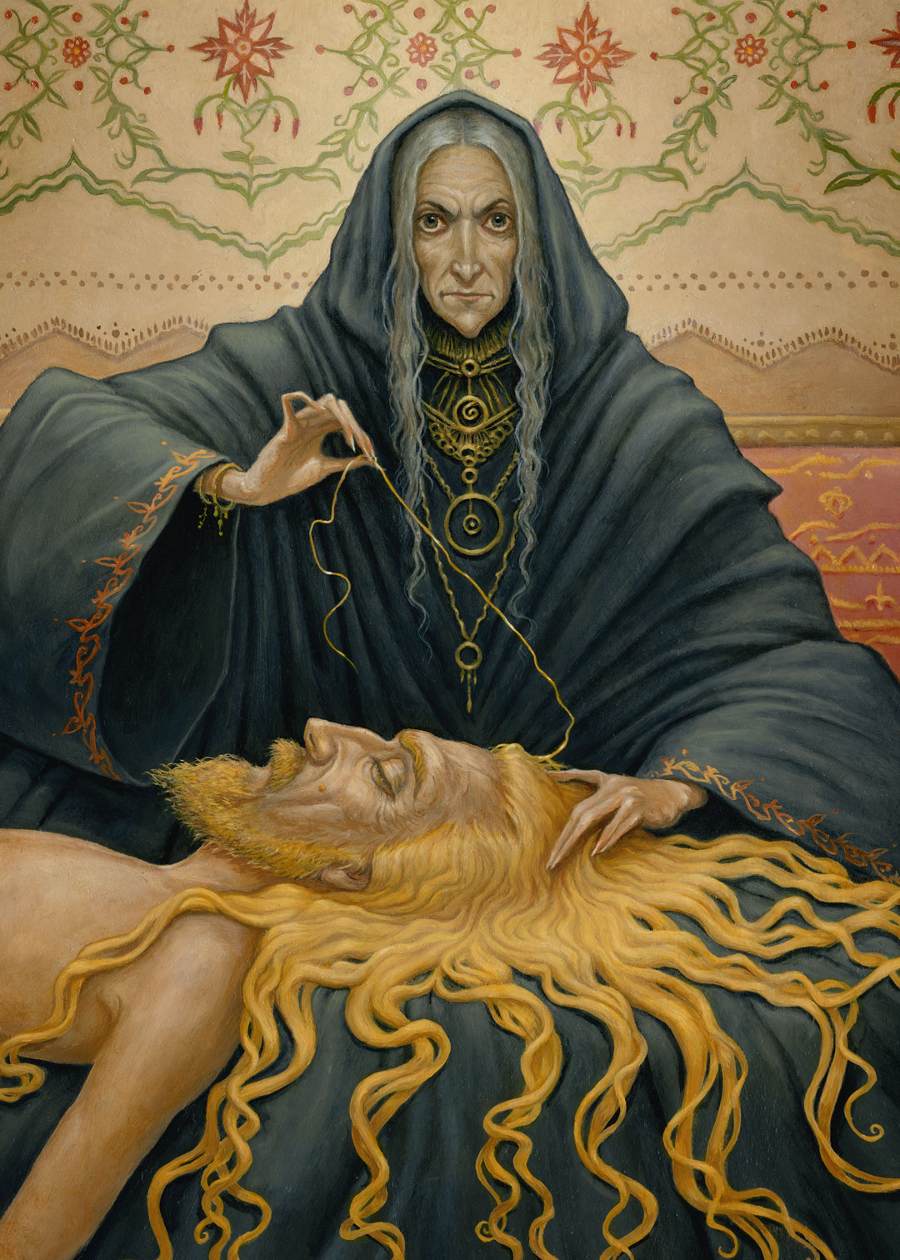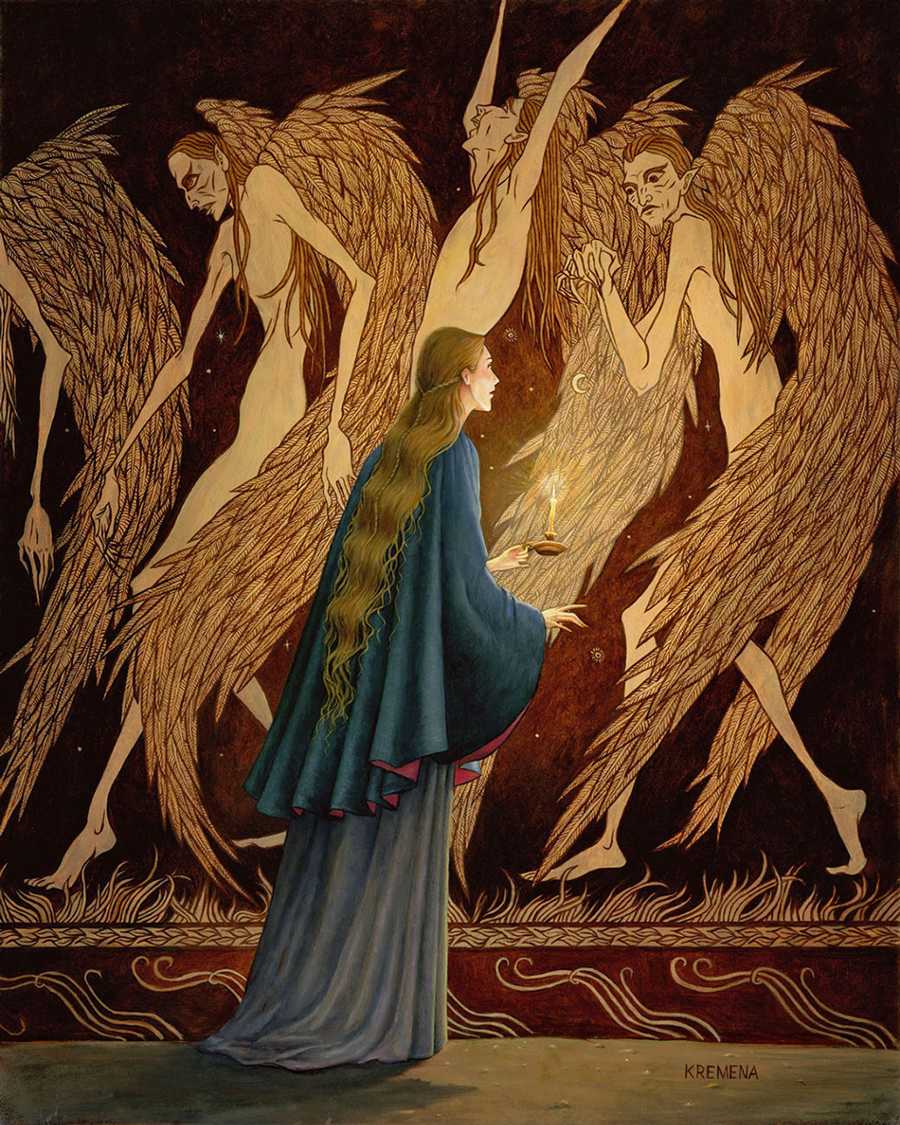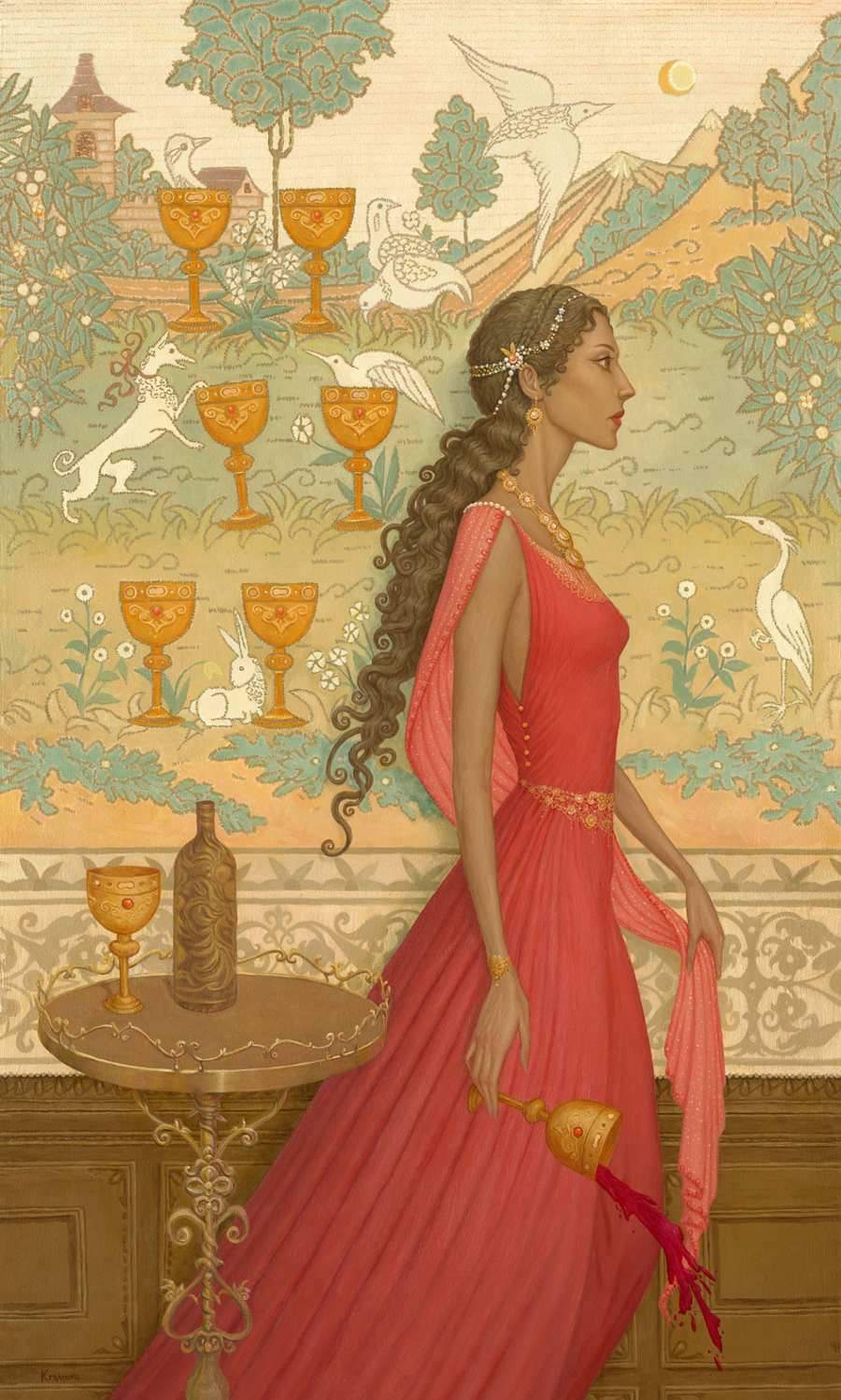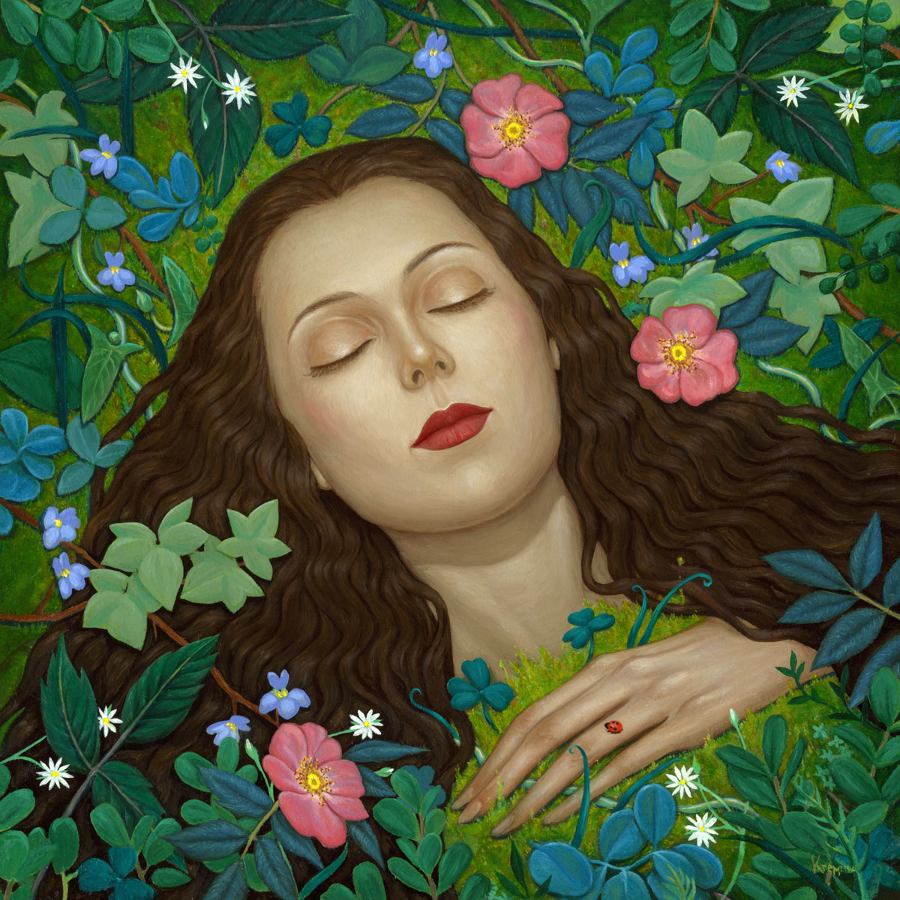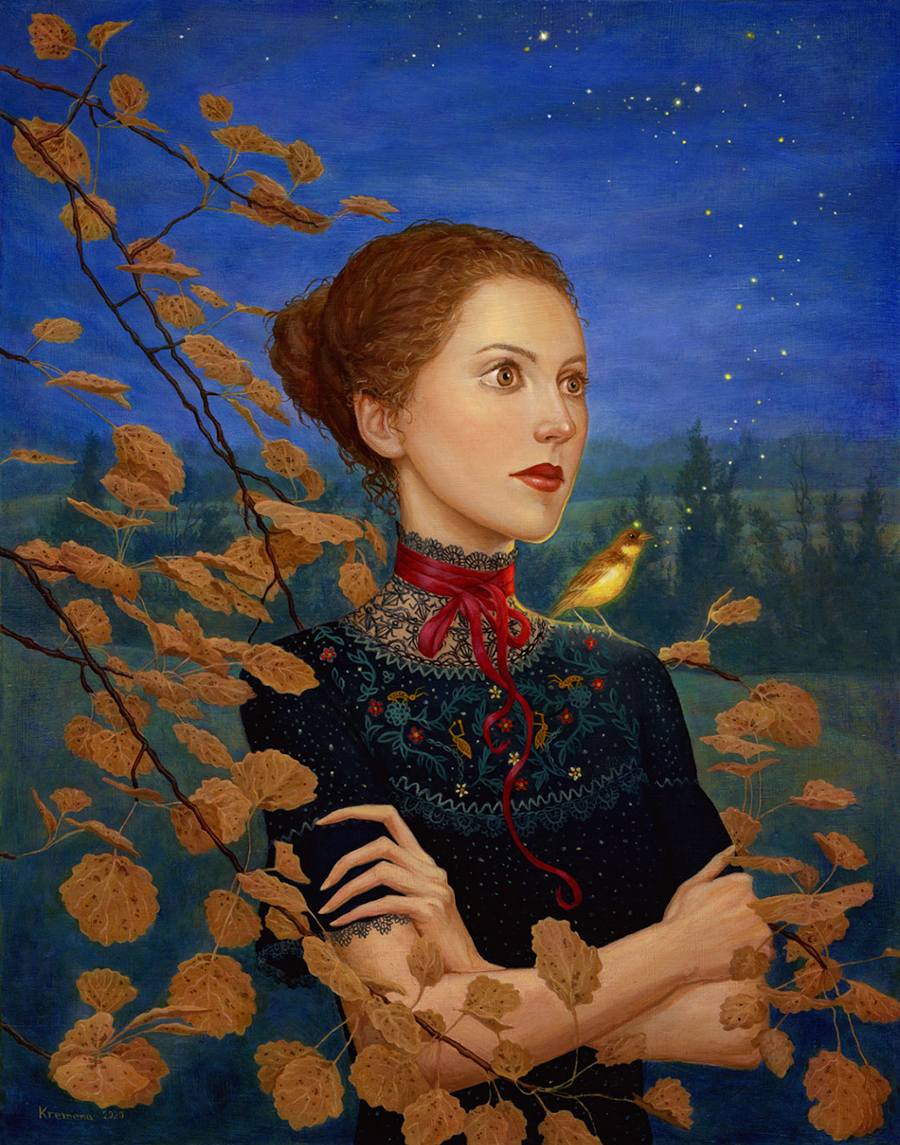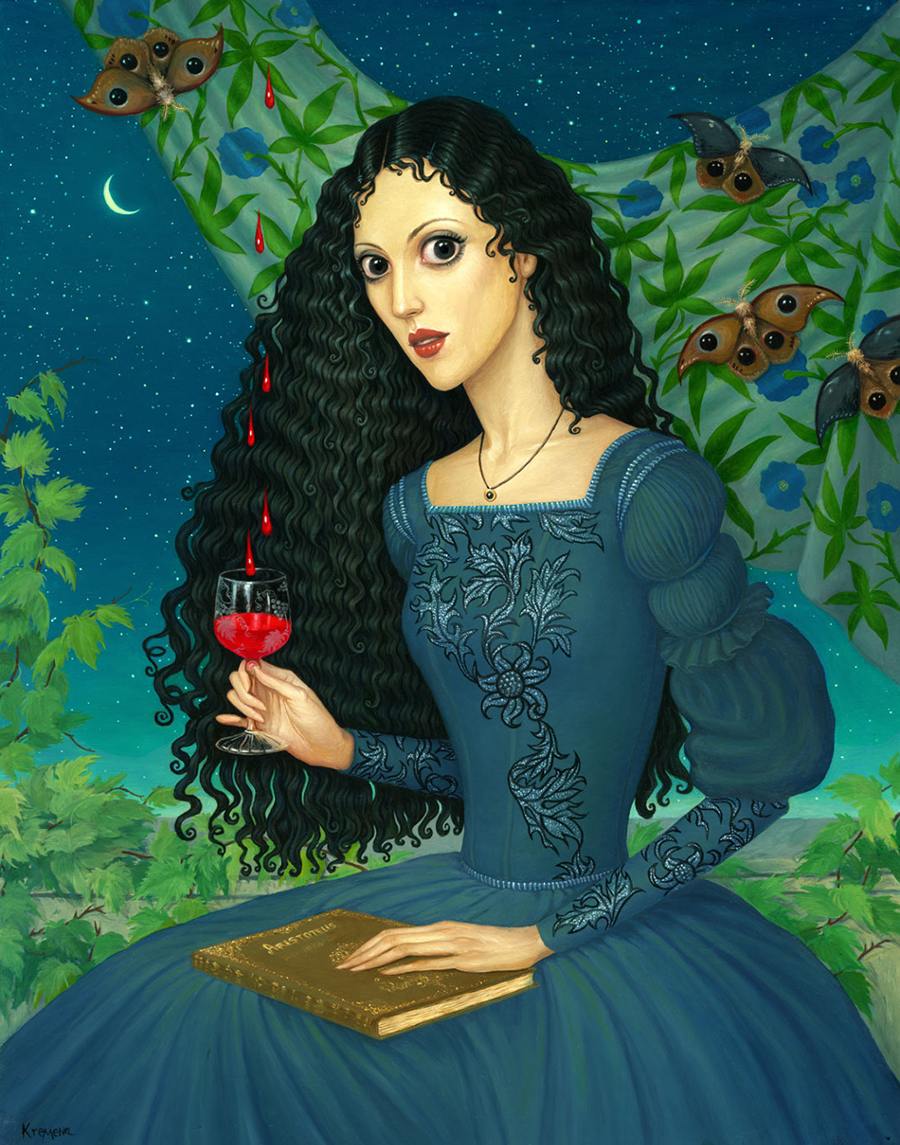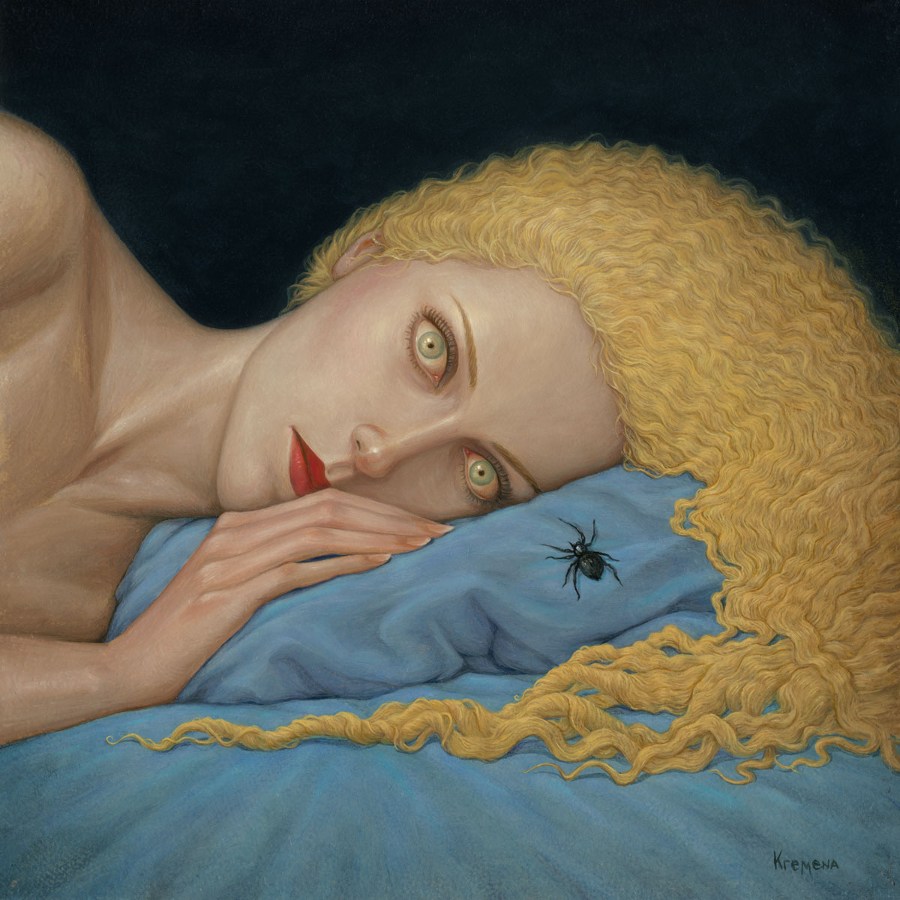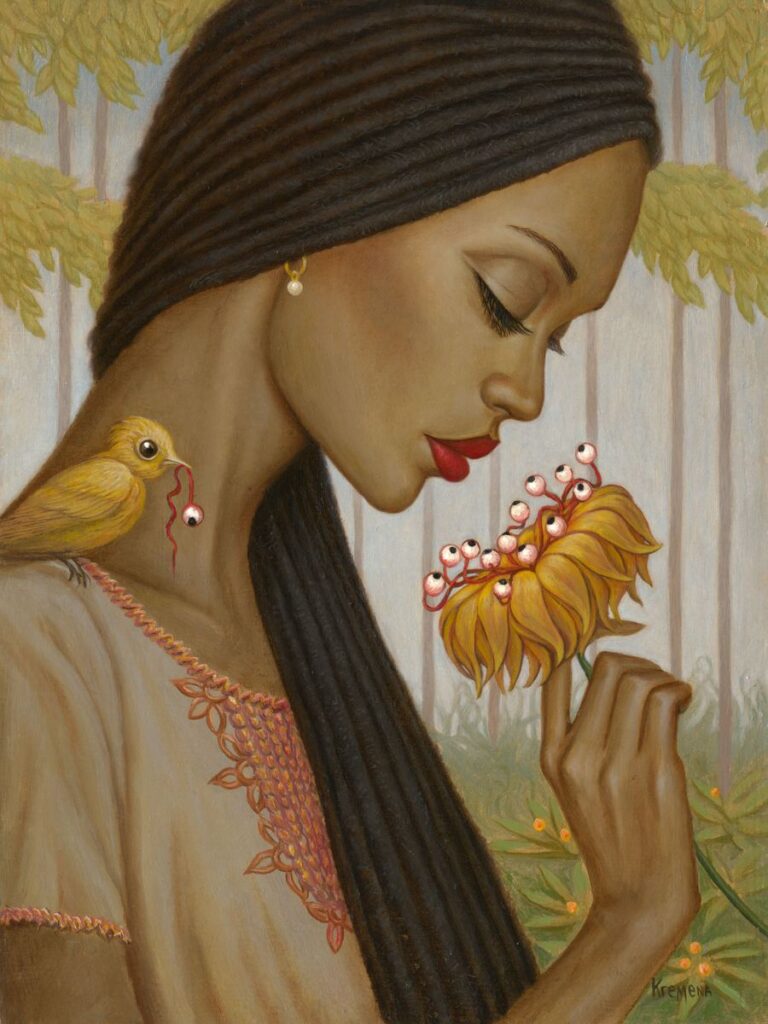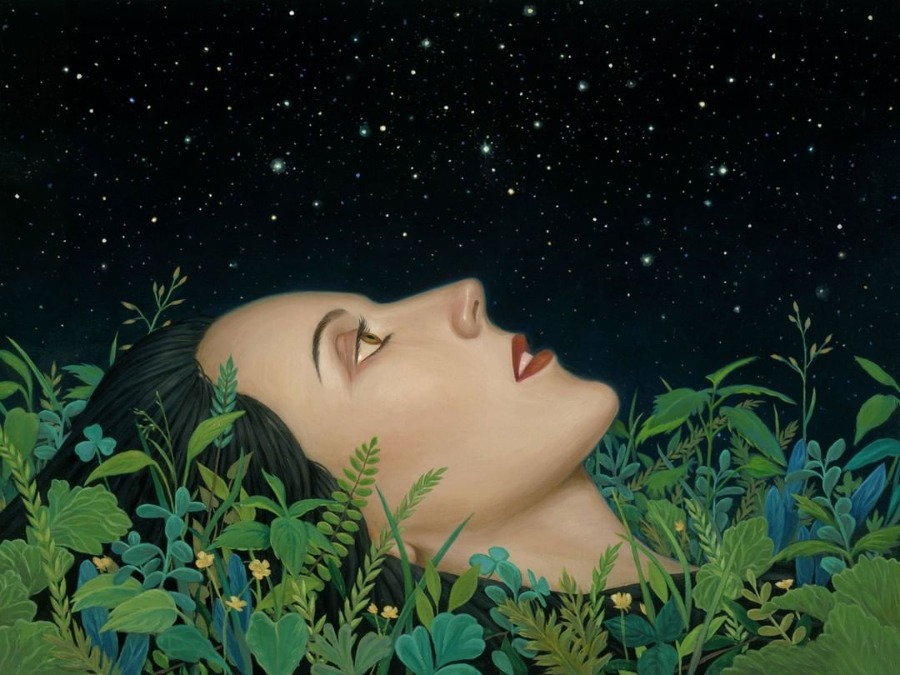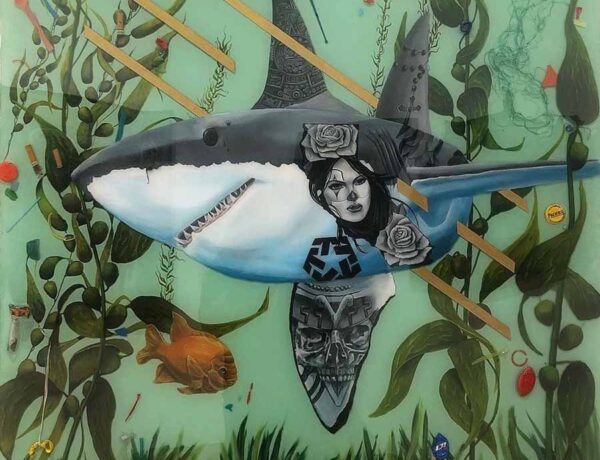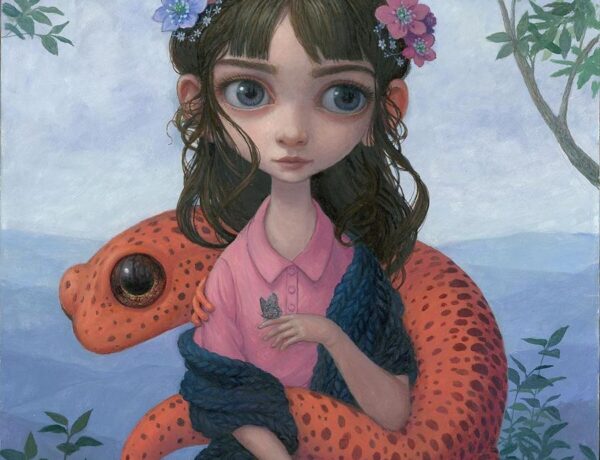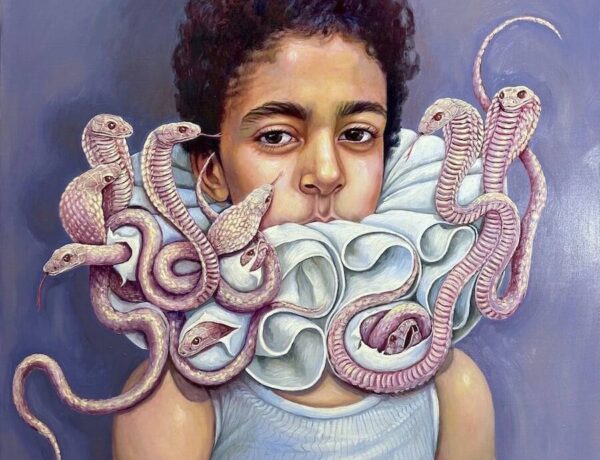“Toto, I’ve a feeling we’re not in Kansas anymore.” ~Lyman Frank Baum, The Wonderful Wizard of Oz
Before we ponder Dorothy Gale’s often misquoted line, let’s touch on creature comforts. Whether metaphorical or tangible, they connect us to the home sweet home that we carry deep within our hearts. Among the reliable ways to tap into those mood-boosting endorphins, eating fresh-out-of-the-oven chocolate chip cookies always works wonders, as does watching baby kitty videos or even revisiting the fables of our youth. Kremena Chipilova’s oil paintings instantly enchant the beholder by summoning our warm fuzzy memories of story time (yayyy!) but then – in the blink of a disembodied eye – they make the sentiments of L. Frank Baum’s adolescent heroine reverberate in our mind.
Hmm, how very odd. Just like that, we’re treading ever so cautiously through the murky depths of a painterly dreamstate filled with dreadful secrets and a looming sense of impending doom. A bony hand extends through a foreboding veil, drawing us ever deeper into a fairytale twilight zone that is both alluring and disconcerting. In a literal sense, Kremena Chipilova’s surreal imaginings bear no physical resemblance to the mind-numbingly flat, monotonously landscaped midwestern American state of Kansas. Her magical realism-saturated artwork does, however, trigger within us an awareness that while we might normally prefer to be nestled amid the comfortable predictability of the plain-Jane place that we call home, first let’s just open this creaky door and slip away into the nebulous possibilities.
I have always enjoyed mystery, magic, strangeness and a little bit of horror, so it seems quite natural for me to develop art that summons that ambiance.
Interview With Kremena Chipilova
Unlike many of the artists we interview who have a genetic component to their talent or they have fond recollections of their creativity being supported and encouraged by their family, that wasn’t the case for you. Would you please paint a picture of your formative years?
Art isn’t a part of my family background at all. I grew up in a small village in Bulgaria and my parents were not encouraging about anything. As long as I was quiet, earned good grades in school, and was out of the way, I was mostly left to my own devices. I liked drawing with whatever I had – usually just a pen and a scrap piece of paper from a notebook – but I didn’t get to explore that side of myself very much.


Some of my muses are definitely wicked, and some could very well be capable of murdering with suitable motivation, but I think most of them are not really evil.
With no real creative cheerleading in your household, it’s surprising that art ended up becoming such a significant part of your life. How did you initially develop interest in it and how did it deepen?
My interest in art has always been there – I really don’t where it comes from – and though I always knew I could draw better than a lot of people, I thought it was because I put effort into it. I didn’t think it was anything special, and neither did my parents. Creating art is something that I could do on my own with just a pen and a notebook. I didn’t need anything or anyone.
At any point in your earlier years did you end up being an art-all-the-time kind of person?
Actually, no. For many years, I was actually an “art-when-I-can” person. For the most part, I spent all my time studying various subjects in school, doing homework and assignments. The only time I could really focus on art was during my summer vacations. When I attended high school and university, I almost forgot I could draw and paint because I was so absorbed with the curriculum and the academic demands. Throughout that time, I also worked at a restaurant, so I had no free time for art.
Elongated fingers and limbs often convey elegance and grace, and I want the women in my paintings to appear more mysterious, otherworldly, and symbolic rather than look like real people.
So, you had absolutely no gut feeling that art would be your path?
No.
After spending five years studying landscape architecture – and then being disheartened by the lack of viable job prospects – it seems like the artsy fates had other plans for you. Tell us about the fortuitous event that sent you down the path that you are currently traveling.
Looking through job listings, I found an opening for a caricaturist at a company that made pastel caricatures on demand that were framed for gifts and special occasions. I saw their finished products and thought I had the skill to draw like that, so I applied, they gave me a test, and I was accepted. That’s when I began to seriously consider art as a viable career choice. They didn’t pay much money, but it wasn’t worse than other options, and I could at least do it from home. I wanted to widen my creative horizons, so at the end of the day after completing my assignments for them, I spent my evenings teaching myself how to work digitally. After 2 years, I moved on because I started getting more digital work which paid better, plus it was more in line with what I wanted to do.
You can do almost anything if you are committed, consistent and don’t give up. To quote Mark Twain: “The secret to getting ahead is getting started”.
Are you largely a self-taught artist, then?
For the basics like composition, human anatomy, etc., I referred to books and the Internet. When I started getting more digital jobs, I enrolled in SmArt School to further develop my skills, which is how I got into the habit of doing thumbnails before committing to the final painting, thanks to Marc Scheff who made us do 100 thumbnails for our assignments.
Thinking about your time as a caricaturist and a gaming/publishing industry artist, did you end up becoming really comfortable using diverse art mediums?
Maybe in the future I may try some different mediums since there is so much to learn. Digital creation never really felt natural to me, but now that I’m painting in oils, I get totally immersed in it – I love it.
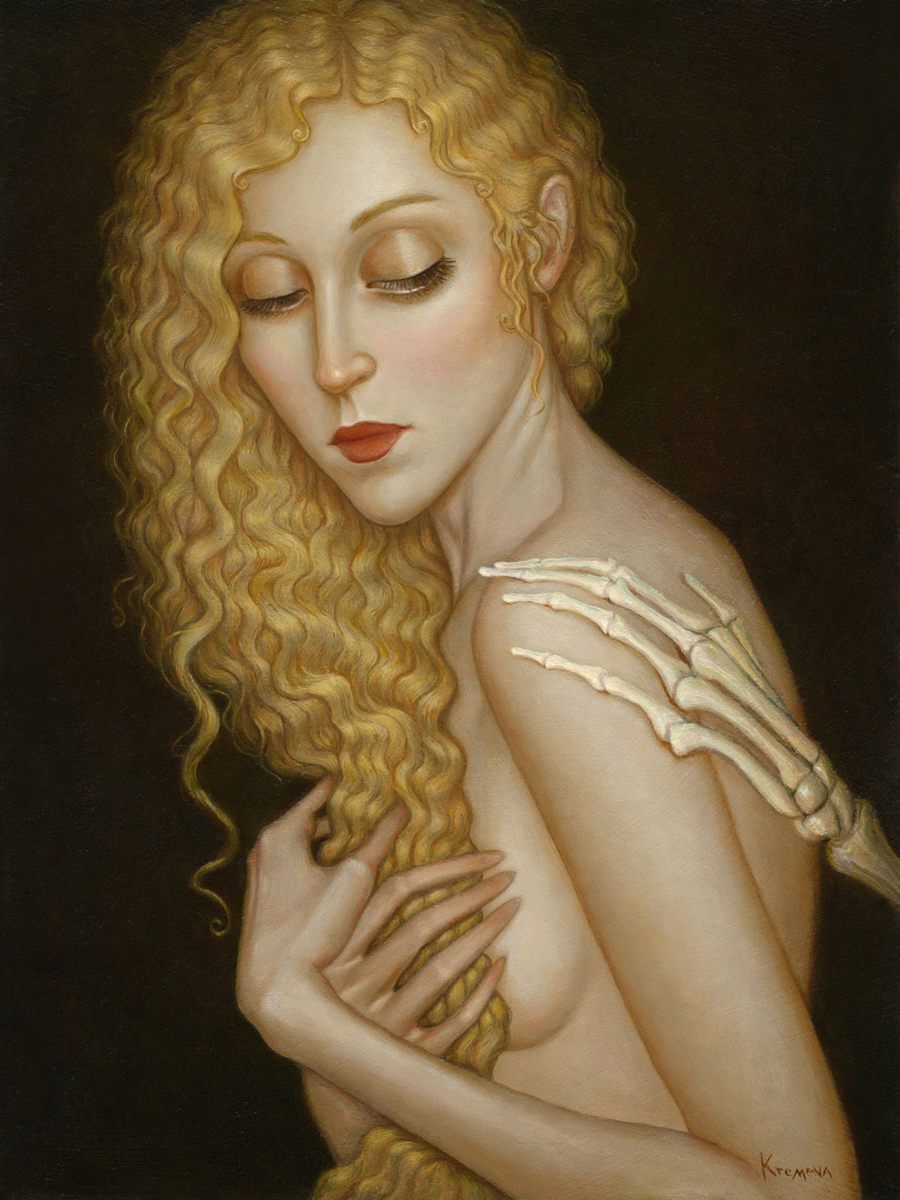
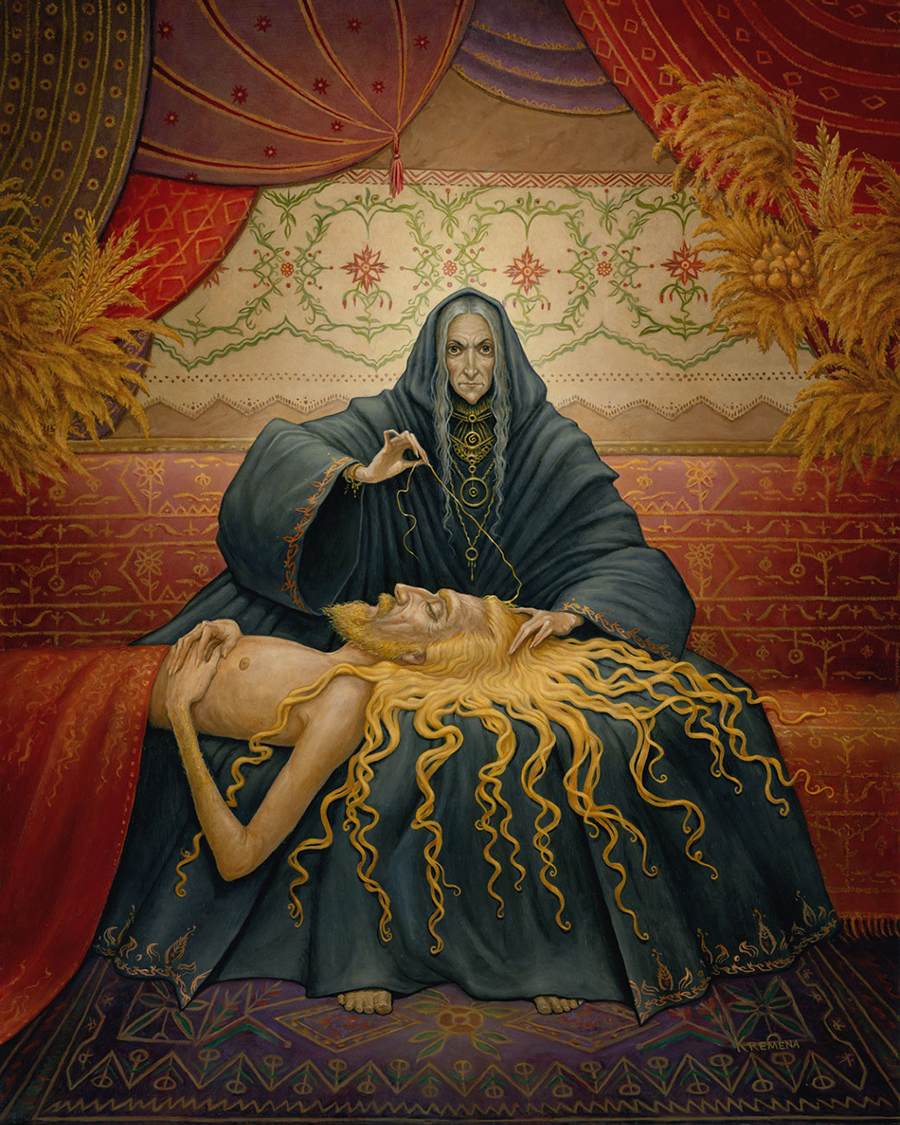
There really is a science behind working with oil paint, so what did it take for you to obtain such refined skills?
When I decided to switch over to oils, I wanted to make sure that I didn’t make rookie mistakes or create paintings that just fall apart. Up until that point, everything I knew was from the Internet – and you can’t trust everything online – so I knew it would be beneficial to have a real human artist confirm if my understanding was right. That’s why I decided to enroll in Annie Stegg Gerard‘s Patreon due to her many informative tutorials, plus I was also in a mentorship with Justin Gerard.
Sometimes death is not bad, but a comfortable, expected, and even welcome visitor. You don’t know if death is the last stage, or if there is something beyond.
You seem rather self-propelled and focused on taking your art career to the next level. With that in mind, it’s not all that surprising that in the mere two years that you’ve been a fine artist, you’ve already developed a refined and instantly recognizable aesthetic. Do you expect that this is the signature that you’ll take with you throughout your career?
I think I am still developing it. In contrast to digital work, painting with oils has given me more space for my natural inclinations, which I like. Also, my aesthetic changes a little from painting to painting. Each piece tells me how it wants to look, but in the end they all have something in common (I hope).
What inspired you to manifest such a distinctively gothic, supernatural-y world? Are darker themes like a warm-and-cozy blanket to you?
As odd as it may sound, yes. Darkness is somehow comforting, natural, and familiar to me. I have never been a very happy or light-hearted person, so my interests and preferences have always revolved around darker themes and genres, whether in literature, movies, music or art. Additionally, I have always enjoyed mystery, magic, strangeness and a little bit of horror, so it seems quite natural for me to develop art that summons that ambiance. Regardless of the medium, I look for inspiration from paintings, novels, poetry…anything, really.
Creating art gets easier in some ways, and harder in other ways. You start challenging yourself more and as you gain more experience, you expect more of yourself, as well.
So…painting pictures of pretty ponies was never in the cards for you, then?
I think artists tend to paint subjects that they have some connection and/or personal experience with because it results in more genuine art. I think that my own thoughts run just a little darker than ponies. I could probably paint ponies too, but it’s possible that I wouldn’t be able to make them as pretty and happy as others who have an affinity for them.
Your artistic narratives tend to make the beholder feel slightly uneasy. We can’t wait to turn the page, yet we find ourselves pausing for more than a few moments because we’re scared to find out what’s lurking on the other side. Are you trying to convey the idea that death is always looming?
I am always preparing for the worst possible situation or expecting something bad to happen. That’s probably why I like the Memento Mori and Vanitas paintings – death is always near. Dance Macabre and Death and the Maiden are among my favorite motifs.
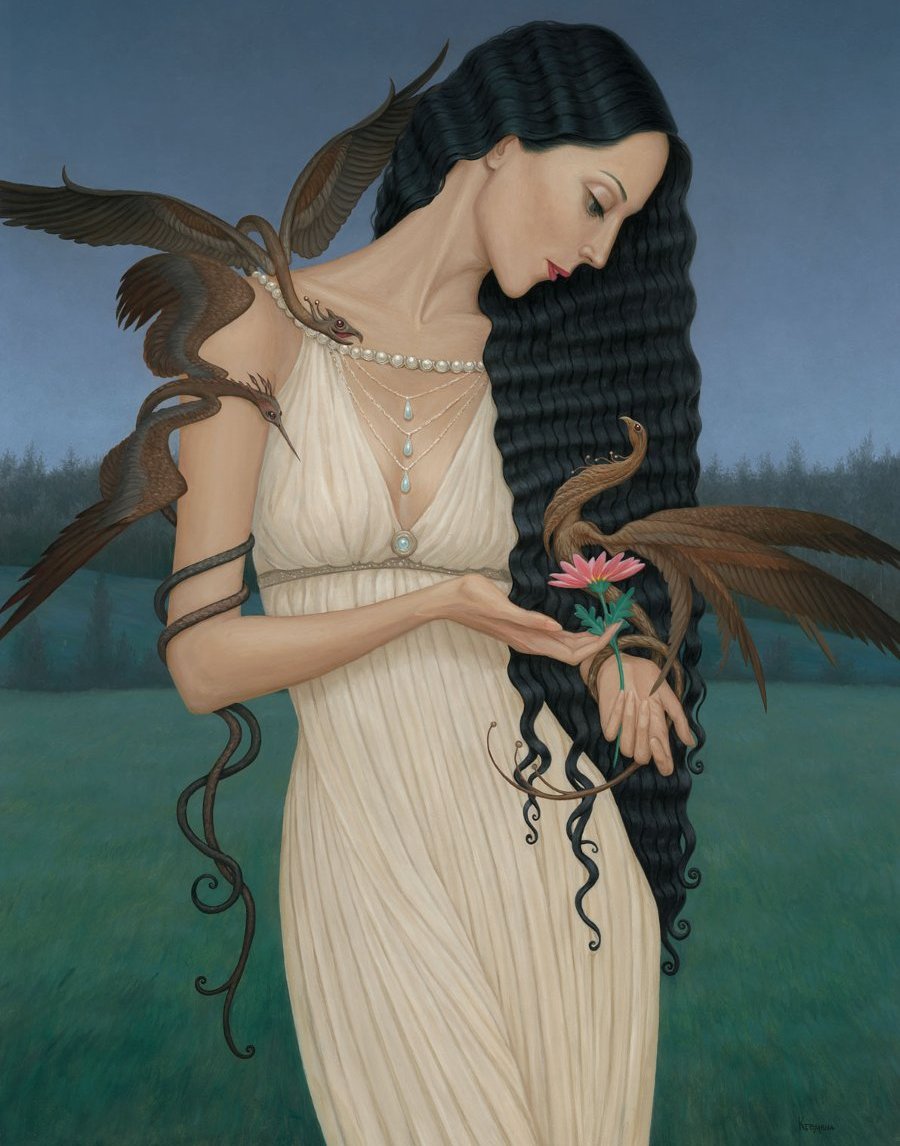

Are the very elongated, skeleton-esque fingers of your muses meant to personify the grim reaper?
I can’t say that I did that intentionally or consciously, but I see what you mean. A few stories developed in my head while painting Her Shadows Caress Me. In one, she is a goddess of death and the shadows (the familiars) are deathbringers. They are not completely dark or scary, though. Sometimes death is not bad, but a comfortable, expected, and even welcome visitor. You don’t know if death is the last stage, or if there is something beyond.
Your muses’ exaggerated limbs bring to mind cool-weird-edgy fashion models, but based on what you’ve shared with us thus far, it seems unlikely that you draw any visual inspiration from that industry. Is that correct?
I have never really used the fashion world as a source of creative inspiration. It’s important to me that what I’m capturing on canvas has a timeless and abstract quality. Elongated fingers and limbs often convey elegance and grace, and I want the women in my paintings to appear more mysterious, otherworldly, and symbolic rather than look like real people.
Darkness is somehow comforting, natural, and familiar to me.
There are various other interesting signature elements in your work, such as your muses’ seemingly larger eyes and the stylistic representation of their hair, but I’m curious what you think your artistic fingerprint is.
Maybe I’ll know the answer to this question in 20 to 30 years. I don’t paint with a particular target style in mind. When I start out, I usually don’t have a perfect vision of what I want a certain element to look like. My goal is to make something that I like, that is evocative, and that fits together as a whole. The same elements can look different between different paintings, so I don’t know that I have a specific goal.
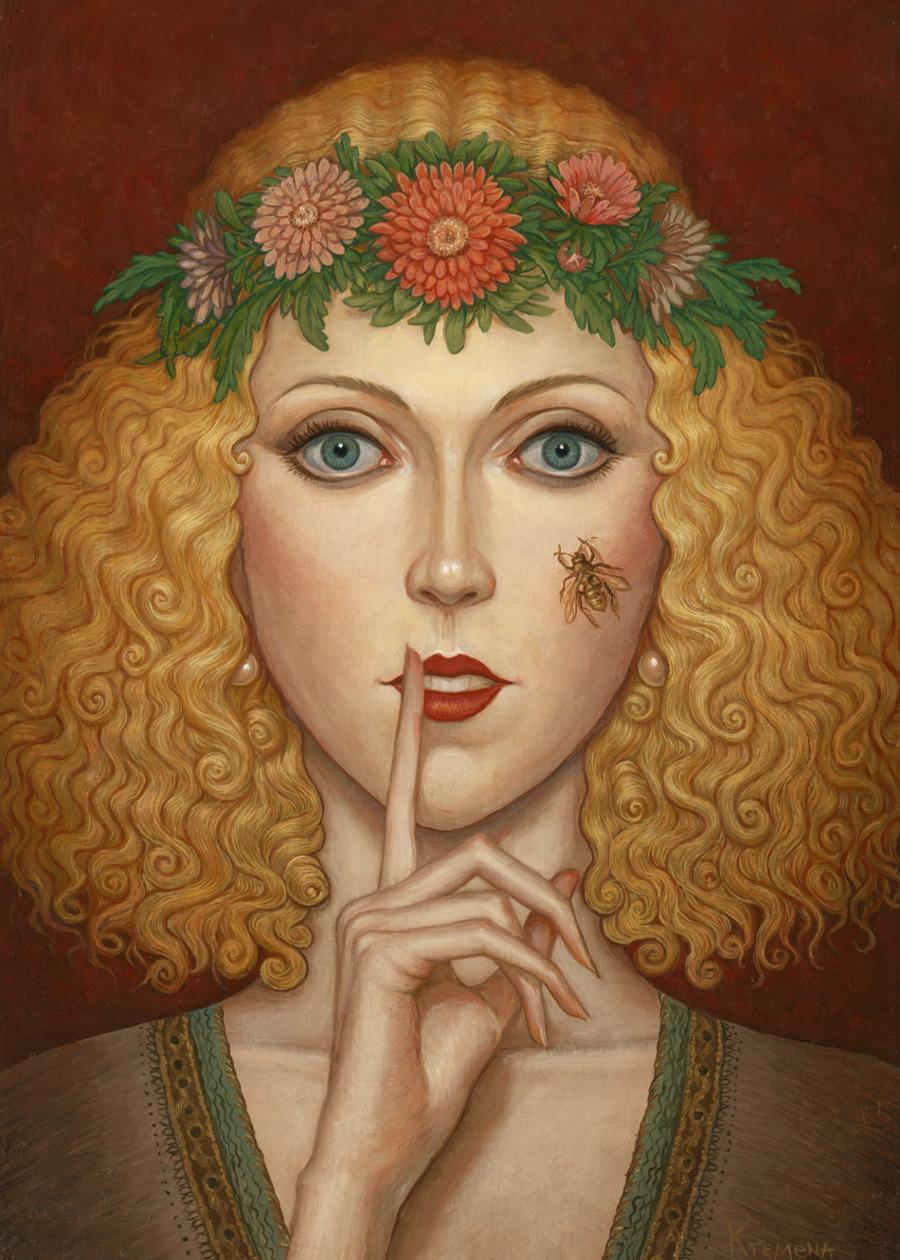
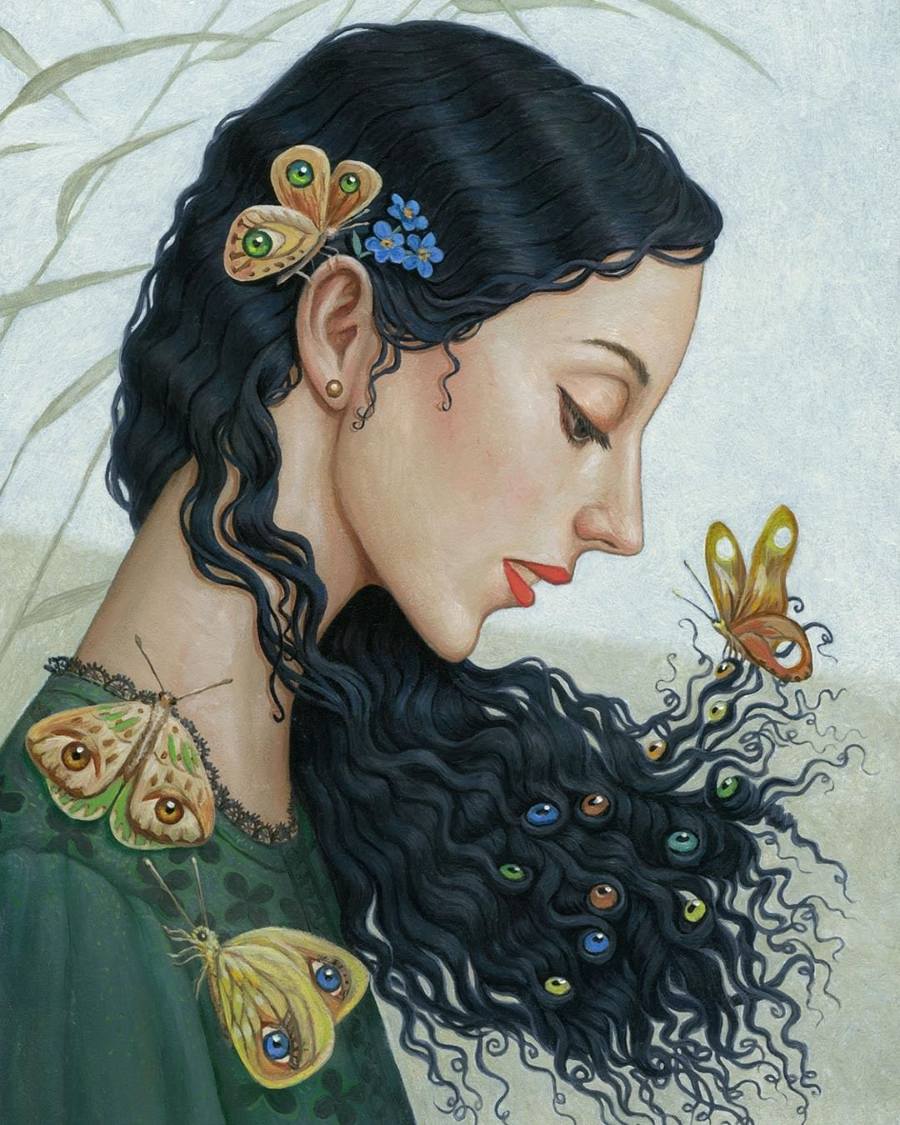
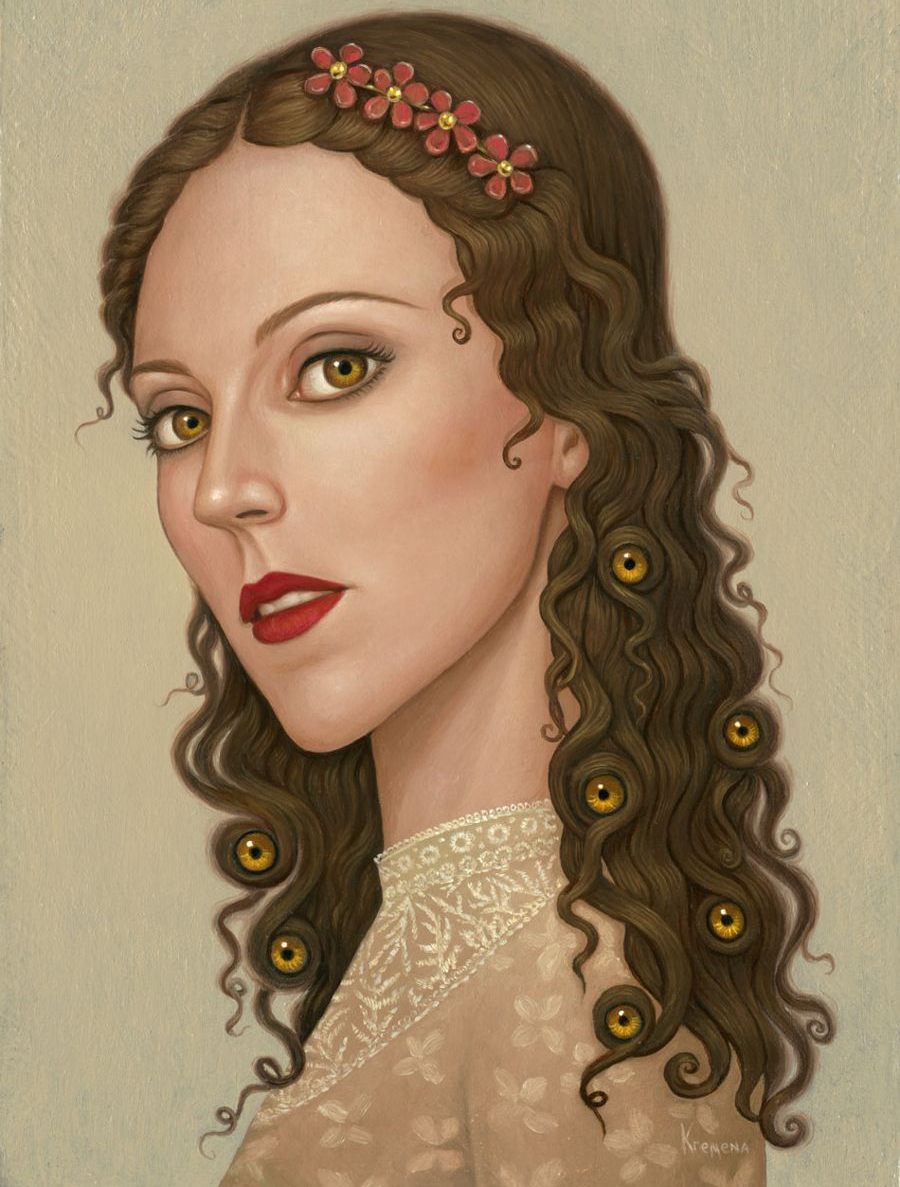
While there is generally a slight variation in the appearance of each of your muses, their facial structure seems sisterly. Do your painted ladies look so strikingly similar to you because you use your own visage as a photographic reference?
I do use myself as reference, so I suspect that’s why there is a visual similarity. Rather than capturing my exact likeness, I adapt it to the particular needs of each narrative. When you use your own photographic references though, some things remain. Overall, I think my muses are a mix between imagination and reality (reference).
Are any of your muses murderers? Some of them truly look capable of some very wicked things.
Some of my muses are definitely wicked, and some could very well be capable of murdering with suitable motivation, but I think most of them are not really evil. At least not by intention, but they could easily play a femme-fatale role.
For many years, I was actually an “art-when-I-can” person. For the most part, I spent all my time studying various subjects in school, doing homework and assignments. The only time I could really focus on art was during my summer vacations.
Why are men and children absent from your paintings? Will they be showing up in the future, or do you intentionally feature ladies as more of a pro-feminist act?
It is not intentional. Men will definitely be present in some of my future paintings. Maybe children are not present for two main reasons – I have always felt old beyond my age and so I have a hard time connecting to an inner child. I don’t have children of my own and I don’t even experience childhood nostalgia. Maybe, since I’m a woman, I feel as though I know women better, so that’s why I feel more comfortable painting them. Being able to use myself as a photographic reference also weighs the scales heavily in that direction, too.
Has the process of creating art gotten a little easier throughout the years? Have any aspects of your art journey fallen into place?
Creating art gets easier in some ways, and harder in other ways. You start challenging yourself more and as you gain more experience, you expect more of yourself, as well. I always thought that it would get easier over time, but it actually doesn’t – it’s the same. Every job has its perks, of course. At this point, I wouldn’t trade my profession for anything.
It sounds like you have much more of a realistic perception of what it means to be a working artist. During moments of insecurity or great duress, what grounding force do you tap into that helps you to stay on your path?
Right now, art is everything for me. It’s a long hard journey, especially if you don’t have support in your early years. I don’t think there is a secret or that it requires special talent – you have to study and work hard, understand the basics and build from there with your own vision. However, you can do almost anything if you are committed, consistent and don’t give up. To quote Mark Twain: “The secret to getting ahead is getting started”. I printed that quote and put it on my wall when switched from a digital, client-oriented career path to creating oil paintings for collectors. Abandoning one path and embarking on a very different one was very scary. That sheet of paper is still there today.
